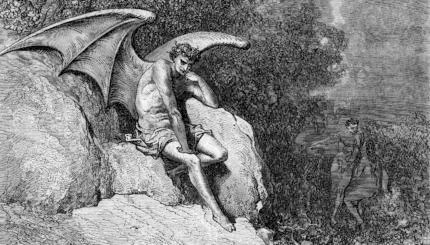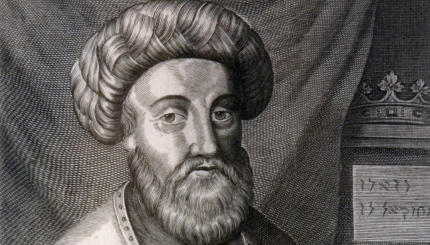Reprinted with permission from
Jewish Ideas Daily.
The most famous and enduring of all Jewish legends is that of the golem, the artificial man. Indeed, with the possible exception of the demon Lilith, briefly pressed into service as a feminist icon, the golem remains the only post-biblical Jewish myth to be widely adopted by non-Jewish culture. Among its recent incarnations are a computer game that bears its name and the army of humanoids who populate James Cameron’s film Avatar.
The Roots of the Golem
The roots of the legend are ancient: the Talmud claims that Adam himself—and thus, theologically speaking, all of humanity—was a golem until God breathed a soul into his nostrils. But the creature as we know it today has a much later and remarkably precise genealogy. He was born in late-16th-century Prague under the auspices of Rabbi Judah Loew ben Bezalel, known as the Maharal, who, using kabbalistic magic, is said to have created a humanoid creature out of mud or clay to defend the Jews from their enemies.
From that point on, versions differ in both details and essentials. We are told that the golem was made out of mud, or ash, or perhaps simply dirt. He was brought to life by the application of magical amulets, or by mystical incantations, or by applying the Hebrew word emet (“truth”) to his body, or by the recitation of the names of God, or, most intriguingly, by intoning the letters of the Hebrew alphabet just as, according to the medieval kabbalistic Book of Creation (Sefer Yetzirah), God created the world.
We do not have any real idea of what the golem looked like, or of his nature. Speculations run from an amorphous but vaguely humanoid blob of clay to a near-perfect simulacrum of a man, lacking only reason and free will. Was he simply crude matter with the appearance of life? Or a living creature whose formative materials happened to be crude matter, as Adam was before the divine breath? In other words, was he something wholly other, or merely an incomplete human being? Perhaps he was both, or neither.
What Did In the Golem?
The accounts of his end are similarly conflicted, leading in turn to divergent understandings of his significance. The most popular and widely known version is that, having successfully defended the Jews, the golem turned on his maker, wreaking havoc in the ghetto, terrifying its inhabitants, and eventually attacking the synagogue he had been created to defend. Thereupon the rabbi destroyed the work of his hands, returning it to the primordial mud whence it came. In a manner befitting the creature’s birth, his destruction was accomplished (or perhaps not) by effacing the letter alef from the word emet, leaving the word met (“dead”).
As it happens, this is a relatively late version of the legendary events. According to an earlier one, perhaps the oldest, the golem proved so powerful that the Holy Roman Emperor himself begged the Maharal to restrain him, promising in return to ensure the security of his Jewish subjects. The rabbi complied, and the golem sleeps to this day in some unknown corner of the Prague ghetto, waiting to be reawakened from his mystical hibernation when his people once again require a champion.
Such is the happy freedom of legends. Today, the golem remains quietly ubiquitous, but also opaque and elusive. While popular culture has successfully visualized and digested the vampire, the werewolf, the ghost, the unicorn, fairies, trolls, witches, and innumerable other ancient personifications of the uncanny and the impossible, the golem still has no concrete visual iconography. We all know that Dracula is Bela Lugosi and Frankenstein is Boris Karloff, but the only even vaguely memorable cinematic depiction of the golem is in a silent German Expressionist film now known mainly to historians, film buffs, and eccentrics.
Interpretations of the Golem
And yet we find the golem himself everywhere: in books, television shows, movies, video games, comic books, even the works of science. Various commentators have pronounced him the progenitor of Frankenstein’s monster, the Terminator, Superman, HAL 9000, and almost any other non-human entity that nonetheless displays vaguely human characteristics. As a universal metaphor, he outdoes even Faust as a symbol of the dark side of knowledge, enlightenment, and technology, if not of modernity itself. The golem has been the atomic bomb, the computer, biotechnology, industrial production, indeed any scientific advance that at one point or another has terrified the human race and sometimes its own creators.
As this suggests, it is the later of the two narratives of the golem’s career—that of the creature gone mad who turned on his creator—that has decisively captured the common imagination. The reasons are obvious. The golem is one of the few monsters that are not obvious holdovers from pagan myth, and the first who was unambiguously man-made. In other words, he is unquestionably modern: the shadow image of a dawning mechanical and technological age in which, for the first time, the artificial would begin to take precedence over nature as the determinative force in human life.
Indeed, the golem emerged out of a topography as artificial as the modern world itself. Unlike his brethren (werewolves, vampires, et al.), he was not born out of the Teutonic black forests, those symbols of the terrifying indifference of nature. He is, instead, unmistakably urban. He is the minotaur at the heart of the labyrinthine city. In this sense, the golem has come to personify the fear that we are all becoming automatons in the grip of a mechanism that we cannot fully comprehend even as we know that it is of our own making, or at least the making of other human beings. Perhaps we see golems everywhere because they are indeed everywhere: the avatars of our artificial environment.
The Jewish Interpretation of the Golem
This, however, refers only to the universal or the common golem. For Judaism, the legend has a wholly other meaning. In Jewish hands, the golem legend is not a horror story, and the cautionary elements in it are subsidiary to a larger theme. The golem was no Frankenstein, let alone a Faustian stand-in, but an avenger created specifically to vanquish the enemies of the Jewish people and, in the legend’s compelling early version, awaiting future summonses to the same service.
A simple revenge fantasy, then? Not quite. Consider the nature of the golem himself. Most cultures build their heroes and avengers out of their idealized selves: their Galahads. But the golem is in every way the antithesis of the ideals of traditional Judaism. In a culture that revered learning and wisdom, the golem is stupid and incapable of reason. In a culture defined by the rigorous discipline of religious law, the golem is unruly, savage, and incapable of self-control. In a culture that took pride in its pacifism, the golem is created expressly for the purpose of committing acts of violence.
So contrary is the golem to the ideals of Jewish tradition that in Jewish circles his name eventually became an insult. To refer to someone as a “golem” is, essentially, to call him an idiot and a fool. The full implications of the insult are suggested by its elective affinity to another term of abuse: goyishe kop, or “Gentile head,” referring to someone of notably low intelligence.
Beyond mere chauvinism, it seems, both terms express a contradiction in the Jewish self-image, what might be called the Gentile at the heart of the Jew. The golem embodies action, power, liberating: qualities officially eschewed but, through the medium of fantasy, projected onto a creature that lives and yet does not live, just as these same qualities lived and yet did not live in the psyche of his creators. This is a creature, moreover, given life not only by the wisdom and knowledge of the Jew but by his rage, his thirst for retribution, his hatred of the life he is forced to endure in exile: a life that appears to be life, but is not.
The Jewish golem, then, emerges as a reification not of the horrors of technology or the inhuman architecture of modern existence but rather of the suppressed forces that Judaism historically preferred to hide from itself: forces that, out of the sheer necessity of survival, eventually erupt, creating a new, Promethean form of life. It is not a coincidence that the awakened golem appears at the dawn of modernity as a close contemporary of the false messiah Shabbetai Tzvi, who unleashed another and much more explicit eruption of the same forces. Indeed, for the Jewish people, modernity has consisted of more than one awakening of the golem.
Whatever may be the universal afterlife of the Maharal’s golem, for Jews and for Judaism the legend foreshadows something very particular: the reacquisition of the capacity for historical power and agency, which is to say the capacity for creation as well as for destruction. It is a capacity that is not to be trifled with—whose exercise, as the legend implicitly recognizes, demands vigilance and discipline. But without it, existence itself lies fallow, formless and void.
Talmud
Pronounced: TALL-mud, Origin: Hebrew, the set of teachings and commentaries on the Torah that form the basis for Jewish law. Comprised of the Mishnah and the Gemara, it contains the opinions of thousands of rabbis from different periods in Jewish history.


